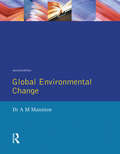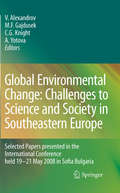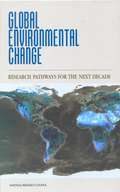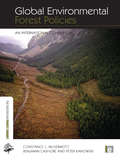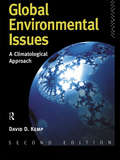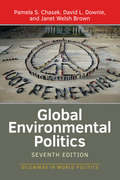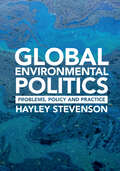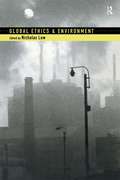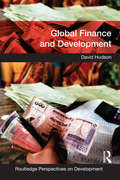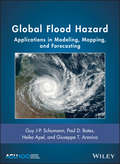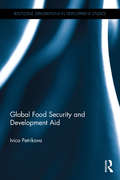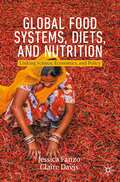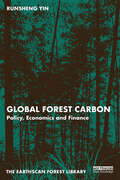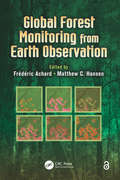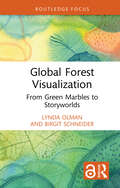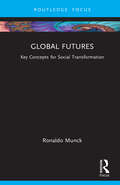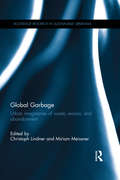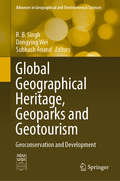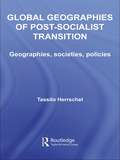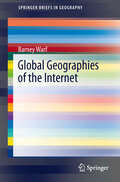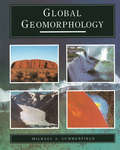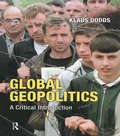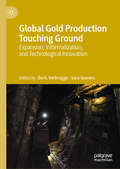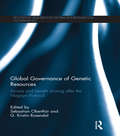- Table View
- List View
Global Environmental Change: A Natural and Cultural Environmental History
by Antoinette MannionNow in its second edition. This text has been extensively revised and rewritten to reflect the growth in environmental research during the last decade. Human-induced environmental change is occurring at such a rapid rate that, inevitably, the fundamental processes involved in biogeochemical cycling are being altered. Global Environmental Change considers alterations to the biogeochemical cycles of carbon, nitrogen, sulphur and other elements as a result of industrial/technological development and agriculture, which have significantly altered the natural environment. The book adopts a temporal and spatial approach to environmental change, beginning with the natural environmental change of the Quaternery period and continuing with the culturally-induced change since the inception of agriculture 10,000 years ago.
Global Environmental Change: Challenges to Science and Society in Southeastern Europe
by Antoaneta Yotova C. Gregory Knight Martin Felix Gajdusek Vesselin AlexandrovSelected papers from the International Conference "Global Environmental Change: Challenges for Science and Society in South-Eastern Europe" held 19-21 May 2008 in Sofia, Bulgaria. Covers changes in climate, land use, carbon and water cycles, air quality, etc.
Global Environmental Change: Research Pathways for the Next Decade
by National Research CouncilHow can we understand and rise to the environmental challenges of global change? One clear answer is to understand the science of global change, not solely in terms of the processes that control changes in climate and the composition of the atmosphere, but in how ecosystems and human society interact with these changes. In the last two decades of the twentieth century, a number of such research efforts--supported by computer and satellite technology--have been launched. Yet many opportunities for integration remain unexploited, and many fundamental questions remain about the earth's capacity to support a growing human population.This volume encourages a renewed commitment to understanding global change and sets a direction for research in the decade ahead. Through case studies the book explores what can be learned from the lessons of the past 20 years and what are the outstanding scientific questions. Highlights include: Research imperatives and strategies for investigators in the areas of atmospheric chemistry, climate, ecosystem studies, and human dimensions of global change.The context of climate change, including lessons to be gleaned from paleoclimatology.Human responses to--and forcing of--projected global change. This book offers a comprehensive overview of global change research to date and provides a framework for answering urgent questions.
Global Environmental Forest Policies: An International Comparison (The Earthscan Forest Library)
by Constance McDermott Benjamin Cashore Peter KanowskiMarket globalization and the globalization of environmental concerns have spurred demand for greater international accountability for forest stewardship. In response, a range of multi-lateral governmental and non-governmental initiatives have emerged to redefine the rules of global trade, and demand verification of the legality and/or sustainability of forest products originating from within and outside national boundaries. At the same time there is a lack of transparency and shared understanding about the environmental forest policies that already exist within the world's leading forest producing and consuming countries. The result is that many stakeholders have developed perceptions about a country's regulatory environment that are not consistent with what is actually taking place. This book provides a uniquely detailed and systematic comparison of environmental forest policies and enforcement in twenty countries worldwide, covering developed, transition and developing economies. The goal is to enhance global policy learning and promote well-informed and precisely tuned policy solutions.
Global Environmental Issues: A Climatological Approach
by David KempThis book provides a balanced account of the global environmental issues which threaten our society and which we neglect at our peril. Analysing both social and environmental components of the issues - global warming, ozone depletion, acid rain and drought - the book offers a valuable integrative approach and a detailed analysis of environmental issues in a clear, non-technical manner. Emphasising the climatological dimension common to all environmental issues, Global Environmental Issues recognises the multi-faceted nature of the issues, their common causes and the possibility of common solutions. Assessment of socio-economic, cultural amd political factors provides a balanced introduction to both the dangers and advantages of human interference with the environment. What have we done to deserve our current environmental crisis? Can we solve our current environmental problems, or is it too late?This new edition of a best selling text is completely updated and expands to include greater detail and new material such as a new section on atmospheric modelling. A glossary has been added together with a bibliography for further reading at the end of each chapter, allowing readers to develop their interest in specific areas. The interdisciplinary text will prove invaluable to students in geography, environmental studies and other courses in whcih the environmental approach is emphasised.
Global Environmental Politics
by Pamela S. Chasek David L. Downie Janet Welsh BrownFor more than twenty years, Global Environmental Politics has provided an up-to-date, accurate, and unbiased introduction to the world's most pressing environmental issues. This new edition continues this tradition while covering critical new developments in the field. Through case studies on key issues such as climate change, toxic chemicals, and biodiversity loss, the authors detail the development of major environmental regimes. With new material on the adoption of global Sustainable Development Goals and the 2030 Agenda for Sustainable Development; the December 2015 Paris Climate Change conference; and recent meetings of major conventions on desertification, biological diversity, and more; the authors present a comprehensive overview of contemporary international environmental politics. Global Environmental Politics is vital reading for any student wishing to understand the current state of the field and to make informed decisions about which policies might best safeguard our environment for the future.
Global Environmental Politics: Problems, Policy and Practice (Routledge Research In Global Environmental Governance Ser.)
by Hayley StevensonConcern about humanity's impact on the planet has never been greater, but what are the drivers of environmental change? This wide-ranging introductory textbook outlines the competing explanations of why environmental problems occur and examines the different political approaches taken to address them. Adopting a case study approach, Hayley Stevenson enables students to gain a detailed understanding of how theories and concepts are applied in practice. Diverse perspectives on a variety of contemporary environmental challenges, from climate change to hazardous waste, as well as various responses, from multilateral diplomacy to consumer-focused campaigns, provide students with an in-depth understanding of the merits and limitations of different forms of political action. Refined on the basis of classroom feedback, features include textboxes, key points, a glossary of key terms, questions, further reading suggestions and supplementary online resources. This lively book is an essential resource for advanced undergraduate and postgraduate courses on global environmental politics and environmental policy.
Global Ethics and Environment
by Nicholas LowAs global capitalism expands and reaches ever-further corners of the world, practical problems continue to escalate and repercussions become increasingly serious and irreversible. These practical problems carry with them equally important and ethical issues.Global Ethics and Environment explores these ethical issues from a range of perspectives and using a wide range of case studies. Chapters focus on: the impact of development in new industrial regions; the ethical relationship between human and non-human nature; the application of ethics in different cultural and institutional contexts; environmental injustice in the location of hazardous materials and processes; the ethics of the impact of a single event (Chernobyl) on the global community; the ethics of transitional institutions.This collection will both stimulate debate and provide an excellent resource for wide-ranging case study material and solid academic context.
Global Finance and Development (Routledge Perspectives on Development)
by David HudsonThe question of money, how to provide it, and how to acquire it where needed is axiomatic to development. The realities of global poverty and the inequalities between the ‘haves’ and the ‘have-nots’ are clear and well documented, and the gaps between world’s richest and the world’s poorest are ever-increasing. But, even though funding development is assumed to be key, the relationship between finance and development is contested and complex. This book explores the variety of relationships between finance and development, offering a broad and critical understanding of these connections and perspectives. It breaks finance down into its various aspects, with separate chapters on aid, debt, equity, microfinance and remittances. Throughout the text, finance is presented as a double-edged sword: while it is a vital tool towards poverty reduction, helping to fund development, more critical approaches remind us of the ways in which finance can hinder development. It contains a range of case studies throughout to illustrate finance in practice, including, UK aid to India, debt in Zambia, Apple’s investment in China, microfinance in Mexico, government bond issues in Chile, and financial crisis in East Asia. The text develops and explores a number of themes throughout, such as the relationship between public and private sources of finance and debates about direct funding versus the allocation of credit through commercial financial markets. The book also explores finance and development interactions at various levels, from the global structure of finance through to local and everyday practices. Global Finance and Development offers a critical understanding of the nature of finance and development. This book encourages the reader to see financial processes as embedded within the broader structure of social relationships. Finance is defined and demonstrated to be money and credit, but also, crucially, the social relationships and institutions that enable the creation and distribution of credit and the consequences thereof. This valuable text is essential reading for all those concerned with poverty, inequality and development.
Global Flood Hazard: Applications in Modeling, Mapping and Forecasting (Geophysical Monograph Series #233)
by Guy J-P. Schumann Paul D. Bates Heiko Apel Giuseppe T. AronicaGlobal Flood Hazard Flooding is a costly natural disaster in terms of damage to land, property and infrastructure. This volume describes the latest tools and technologies for modeling, mapping, and predicting large-scale flood risk. It also presents readers with a range of remote sensing data sets successfully used for predicting and mapping floods at different scales. These resources can enable policymakers, public planners, and developers to plan for, and respond to, flooding with greater accuracy and effectiveness. Describes the latest large-scale modeling approaches, including hydrological models, 2-D flood inundation models, and global flood forecasting models Showcases new tools and technologies such as Aqueduct, a new web-based tool used for global assessment and projection of future flood risk under climate change scenarios Features case studies describing best-practice uses of modeling techniques, tools, and technologies Global Flood Hazard is an indispensable resource for researchers, consultants, practitioners, and policy makers dealing with flood risk, flood disaster response, flood management, and flood mitigation.
Global Food Security and Development Aid (Routledge Explorations in Development Studies)
by Ivica PetrikovaAt the global level, international actors have repeatedly expressed their desire to end hunger and food insecurity. However, food insecurity has persisted. More analysis is hence needed on the link between continuously high levels of global food insecurity and the ever increasing flow of development aid. Global Food Security and Development Aid investigates the impact that development aid has had on food security in developing countries and includes international case studies on Peru, Ethiopia, India and Vietnam. It examines the effect of development aid in general and the impact of aid divided into different categories based on donor, mechanism and sector to which it is provided. In each examined relationship between aid and food security, particular attention is paid to the potentially intervening role played by the quality of national and/or local governance. The book makes policy recommendations, most importantly that donors should take greater care in considering which types of aid are suitable to which specific countries, localities, and development goals, and account for expected developments in the complex relationship between aid, food security, and governance. This book will be of considerable interest to students, researchers and policy-makers in the areas of development aid and food security.
Global Food Systems, Diets, and Nutrition: Linking Science, Economics, and Policy (Palgrave Studies in Agricultural Economics and Food Policy)
by Claire Davis Jessica FanzoEnsuring optimal diets and nutrition for the global population is a grand challenge fraught with many contentious issues. To achieve food security for all and protect health, we need functional, equitable, and sustainable food systems. Food systems are highly complex networks of individuals and institutions that depend on governance and policy leadership. This book explains how interconnected food systems and policies affect diets and nutrition in high-, middle-, and low-income countries. In tandem with food policy, food systems determine the availability, affordability, and nutritional quality of the food supply, which influences the diets that people are willing and able to consume. Readers will become familiar with both domestic and international food policy processes and actors, and they will be able to critically analyze and debate how policy and science affect diet and nutrition outcomes.
Global Forest Carbon: Policy, Economics and Finance (The Earthscan Forest Library)
by Runsheng YinThis book addresses the major policy, economic and financial issues encountered in global forest carbon.The global forest sector is expected to play a major role in achieving the Paris Agreement’s temperature targets. Therefore, there is an urgent need to explore practical and promising solutions to the challenges facing carbon accounting and policy assessment as the global community undertakes forest sector actions—including the widely known REDD+ initiative. This book demonstrates how vital it is that we identify appropriate perspectives and formulate approaches to address these challenges in an integrated and effective manner. In doing so, it addresses many of the major issues, including the differential potentials for carbon sequestration within various forest ecosystems as well as for storage within a variety of harvested wood products, the joint production of timber and carbon, and the measurement and impact of forest carbon offsets and credits, results-based payments, and other nationally determined contributions centered differences as well. The book examines regional and country-level case studies from across the world and draws on the author's decades of experience working on forest policy and with the forest sector. Overall, this book highlights the technical and policy issues regarding forest sector carbon emission and removal to build useful perspectives, frameworks, and methods for addressing these issues successfully in the future. It advances the knowledge frontiers of global forest carbon policy, economics and finance as well as the ability to assess the effectiveness, efficiency, and equity of forest climate solutions.This book is essential reading for professionals and policymakers working at the intersection of forest policy, carbon storage and climate change, as well as students and researchers in the fields of forestry, natural resource management, climate change and nature-based solutions.
Global Forest Governance and Climate Change: Interrogating Representation, Participation, And Decentralization (Palgrave Studies In Natural Resource Management Ser.)
by Emmanuel O. NuesiriThis edited collection assesses governance in forestry programmes and projects, including REDD+ governance. It examines political representation, participation and decentralisation in forest governance, providing insight as to how forest governance arrangements can be responsive to the socio-economic interests of local people and communities who live adjacent to and depend on forests.Global Forest Governance and Climate Change argues that inclusive complementary representation of local communities is required for strong participatory processes and democratic decentralisation of forest governance. Responsiveness to local people’s socio-economic interests in forestry initiatives require paying attention to not just the hosting of participatory meetings and activities, but also to the full cast of appointed, self-authorized, and elected representative agents that stand, speak, and act for local people. This book will be of interest to students and academics across the fields of climate change governance, forestry, development studies, and political economy. It will also be a useful resource for policy makers and practitioners responsible for forestry and climate change initiatives.
Global Forest Monitoring from Earth Observation
by Frédéric Achard • Matthew C. HansenCovering recent developments in satellite observation data undertaken for monitoring forest areas from global to national levels, this book highlights operational tools and systems for monitoring forest ecosystems. It also tackles the technical issues surrounding the ability to produce accurate and consistent estimates of forest area changes, which are needed to report greenhouse gas emissions and removals from land use changes. Written by leading global experts in the field, this book offers a launch point for future advances in satellite-based monitoring of global forest resources. It gives readers a deeper understanding of monitoring methods and shows how state-of-art technologies may soon provide key data for creating more balanced policies.
Global Forest Visualization: From Green Marbles to Storyworlds (Routledge Focus on Environment and Sustainability)
by Birgit Schneider Lynda OlmanThis book project examines global forest monitoring as a means to understand the promises and problems of global visualization for climate management.Specifically, the book focuses on Global Forest Watch, the most developed and widely available forest-monitoring platform, created in 1997 by the World Resource Institute. Forest maps are always political as they visualize power relations and form the grid within which forests become commodities. This dislocation of the idea of the forest from its literal roots in the ground has generated problems for forest visualization efforts designed to empower local communities. This book takes a critical humanistic approach to this problem, combining methods from the fields of rhetoric and media studies to suggest solutions to these problems for designers and users of platforms like the Global Forest Watch. To explain why global views of forests can be disempowering, the book relies on biopolitical and rhetorical theories of panopticism and how these views unfold a different violence on different regions of the Earth in relation to colonial history. Using this theoretical framework, the book explains the historical process by which forests came to be classified, quantified, and mapped on a global scale. Interviews with end-users of global forest visualization platforms reveal if and how these platforms support local action. Lastly, the book provides rhetorical solutions to articulate global and local views of forests without reducing one view to the other. These solutions involve looking to forests themselves for clues about how to generate more broadly effective and resilient visualizations.This book will be of great interest to students and scholars of forest studies, climate change, science communication, visualization studies, environmental communication, and environmental conservation.The Open Access version of this book, available at http://www.taylorfrancis.com, has been made available under a Creative Commons [Attribution-Non Commercial-No Derivatives (CC-BY-NC-ND)] 4.0 license.
Global Futures: Key Concepts for Social Transformation (Routledge Critical Development Studies)
by Ronaldo MunckGlobal Futures: Key Concepts for Social Transformation provokes us to rethink some of the key words and concepts which define the current global order. Prompted by crises around the world, it seeks to re-energise our desire for a better future.The book takes seven key concepts from the new global studies and considers how they are used and whether they are adequate for addressing the twenty-first century's increasingly complex global order. The topics covered include widely used concepts such as development, modernity, history, and politics, as well as more unusual themes such as desire, complexity, and alternative futures. The core message of this book is that we need to grasp the complex and contradictory reality behind these important concepts in order to foster a new way of thinking, seeing, and acting for a future fit for human purpose.Written by Ronaldo Munck, a key social theorist and social activist with a Latin American and European background, this book will be perfect for students and researchers of sociology, politics, international relations, and global development.
Global Garbage: Urban imaginaries of waste, excess, and abandonment (Routledge Research in Sustainable Urbanism)
by Christoph Lindner Miriam MeissnerGlobal Garbage examines the ways in which garbage, in its diverse forms, is being produced, managed, experienced, imagined, circulated, concealed, and aestheticized in contemporary urban environments and across different creative and cultural practices. The book explores the increasingly complex relationship between globalization and garbage in locations such as Beirut, Detroit, Hong Kong, London, Los Angeles, Manchester, Naples, Paris, Rio de Janeiro and Tehran. In particular, the book examines how, and under what conditions, contemporary imaginaries of excess, waste, and abandonment perpetuate – but also sometimes counter – the imbalances of power that are frequently associated with the global metropolitan condition. This interdisciplinary collection will appeal to the fields of anthropology, architecture, film and media studies, geography, urban studies, sociology, and cultural analysis.
Global Geographical Heritage, Geoparks and Geotourism: Geoconservation and Development (Advances in Geographical and Environmental Sciences)
by R. B. Singh Subhash Anand Dongying WeiThis book explores the geographical, geomorphological, ecological, touristic and socioeconomic aspects of natural heritage, argues for the dynamic conservation of that heritage and explains its key characteristics, promotion, conservation and management to achieve sustainable development goals. Emerging concepts such as geodiversity, geographical heritage sites, geomonuments, geoparks and geotourism are increasingly being used by conservationists. At present, the development of geoparks is a major global theme involving the application of geosciences to promote the inclusive growth of society and the protection and conservation of our unique geoheritage. Currently, there are 147 UNESCO global geoparks across 41 countries, in addition to a number of national-level geoparks. Pursuing a holistic approach towards such sites will sensitise the general public to the need for geoconservation of significant geosites and promote it through geotourism. It is a crucial issue, as various countries around the world are eager to develop their geoparks and are working for the conservation of geoheritage sites at the national level. This unique book gathers contributions from 15 countries in the form of case studies analysing the realities on of geographical heritage, geoparks and geotourism. The respective chapters address the role of geoparks as essential tools for education, recreation and nature conservation. Given its scope, the book offers a valuable guide for geoscientists, planners, policymakers, civil society and anyone concerned about the conservation of geoheritage sites and geoparks for a sustainable future Earth.
Global Geographies of Post-Socialist Transition: Geographies, societies, policies (Routledge Studies in Human Geography)
by Tassilo HerrschelSince the formal raising of the Iron Curtain, there has been much interest in post-socialism and the process of post-socialist transition. This timely book provides a systematic review and analysis of the process of ‘transition’. Herrschel: explores recent theories, concepts and debates on post-socialism and the notion of transition provides a systematic, topical account of post-socialist transitions around the world, as evidence by social, economic, and political processes examines case studies of post-socialist transition in east and Central Europe, the former Soviet Union, Asia and South-East Asia, and Africa and Latin America brings together theoretical and practical aspects by examining what lessons can be learned from recent experiences. Global Geographies of Post-Socialist Transition provides a truly global comparative account of the meaning and processes of post-socialist transition and will be an invaluable resource for all those interested in this area.
Global Geographies of the Internet
by Barney WarfToday, roughly 2 billion people use the internet, and its applications have flourished in number and importance. This volume will examine the growth and geography of the internet from a political economy perspective. Its central motivation is to illustrate that cyberspace does not exist in some aspatial void, but is deeply rooted in national and local political and cultural contexts. Toward that end, it will invoke a few major theorists of cyberspace, but apply their perspectives in terms that are accessible to readers with no familiarity with them. Beyond summaries of the infrastructure that makes the internet possible and global distributions of users, it delves into issues such as the digital divide to emphasize the inequalities that accompany the growth of cyberspace. It also addresses internet censorship, e-commerce, and e-government, issues that have received remarkably little scholarly attention, particularly from a spatial perspective. Throughout, it demonstrates that in cyberspace, place matters, so that no comprehensive understanding of the internet can be achieved without considering how it is embedded within, and in turn changes, local institutional and political contexts. Thus the book rebuts simplistic "death of distance" views or those that assert there is, or can be, a "one-size-fits-all, cookie-cutter" model of the internet applicable to all times and places.
Global Geomorphology
by Michael A. SummerfieldThe plate tectonics revolution in the earth sciences has provided a valuable new framework for understanding long-term landform development.This innovative text provides a comprehensive introduction to the subject of global geomorphology, with the emphasis placed on large-scale processes and phenomena. Integrating global tectonics into the study of landforms and incorporating planetary geomorphology as a major component the author discusses the impact of climatic change and the role of catastrophic events on landform genesis and includes a comprehensive study of surface geomorphic processes.
Global Geopolitics: A Critical Introduction
by Klaus J. DoddsEmploying thematic investigation and illustrated through case studies, Dodds explores how global politics is imagined and practised by countries such as the US and other organisations including Greenpeace, the IMF and CNN International.In addition, the author discusses how issues such as environmental degradation, terror networks, anti-globalisation protests and North-South relations challenge, consolidate and subvert the existing international political system.
Global Gold Production Touching Ground: Expansion, Informalization, and Technological Innovation
by Sara Geenen Boris VerbruggeIn recent decades, gold mining has moved into increasingly remote corners of the globe. Aside from the expansion of industrial gold mining, many countries have simultaneously witnessed an expansion of labor-intensive and predominantly informal artisanal and small-scale gold mining. Both trends are usually studied in isolation, which contributes to a dominant image of a dual gold mining economy. Counteracting this dominant view, this volume adopts a global perspective, and demonstrates that both industrial gold mining and artisanal and small-scale gold mining are functionally integrated into a global gold production system. It couples an analysis of structural trends in global gold production (expansion, informalization, and technological innovation) to twelve country case studies that detail how global gold production becomes embedded in institutional and ecological structures.
Global Governance of Genetic Resources: Access and Benefit Sharing after the Nagoya Protocol (Routledge Research in Global Environmental Governance)
by Sebastian Oberthür G. Kristin RosendalThis book analyses the status and prospects of the global governance of Access Benefit Sharing (ABS) in the aftermath of 2010’s Nagoya Protocol to the Convention on Biological Diversity (CBD). The CBD’s initial 1992 framework of global ABS governance established the objective of sharing the benefits arising from the use of genetic resources fairly between countries and communities. Since then, ABS has been a contested issue in international politics – not least due to the failure of effective implementation of the original CBD framework. The Nagoya Protocol therefore aims to improve and enhance this framework. Compared to the slow rate of progress on climate change, it has been considered a major achievement of global environmental governance, but it has also been coined a ‘masterpiece of ambiguity’. This book analyses the role of a variety of actors in the emergence of the Nagoya Protocol and provides an up-to-date assessment of the core features of the architecture of global ABS governance. This book offers a central resource regarding ABS governance for those working on and interested in global environmental governance. This is achieved by focusing on two broad themes of the wider research agenda on global environmental governance, namely architecture and agency. Furthermore, individual chapter contributions relate and link ABS governance to other prominent debates in the field, such as institutional complexes, compliance, market-based approaches, EU leadership, the role of small states, the role of non-state actors and more. Partly due to its seeming technical complexity, ABS governance has so far not been at the centre of attention of scholars and practitioners of global environmental governance. In this book, care is taken to provide an accessible account of key functional features of the governance system which enables non-specialists to gain a grasp on the main issues involved, allowing the issue of ABS governance to move centre-stage and be more fully recognised in discussions on global environmental governance.
